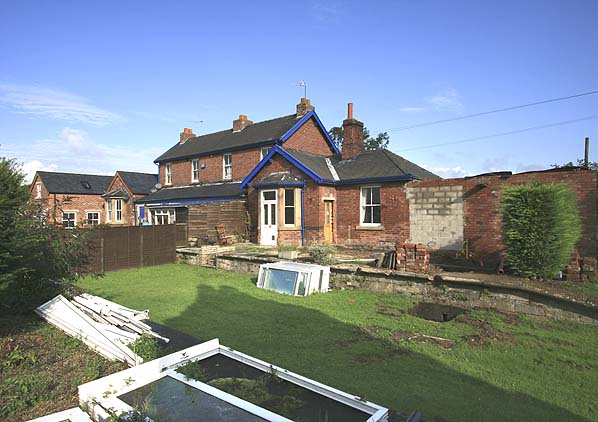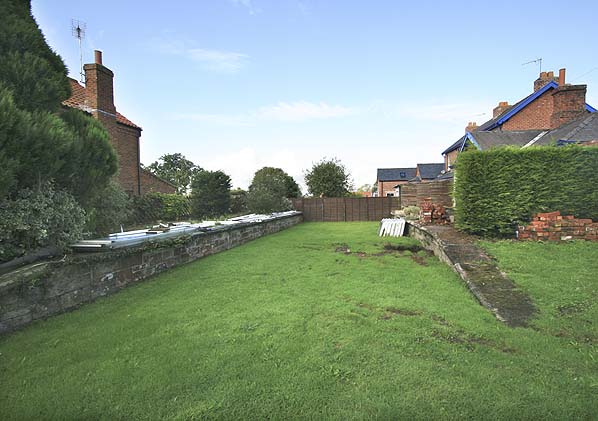
Station Name: SNAINTON
|
| Date opened: | 1.5.1882 |
| Location: | At the junction of Foulbridge Lane and Middle Lane which is at the end of Station Road. |
| Company on opening: | North Eastern Railway |
| Date closed to passengers: | 5.6.1950 |
| Date closed completely: | 5.6.1950 |
| Company on closing: | British Railways (North Eastern Region) |
| Present state: | The station is in single ownership but has been divided into two residences with a fence across the track. The main station buildings are in good condition although the waiting shelter on the up platform has been demolished. The east end of both platforms survive it is not know whether the west ends are also extant. |
| County: | Yorkshire |
| OS Grid Ref: | SE919818 |
| Date of visit: | 7.9.2008 |
Notes: Snainton was the principal station on the Forge Valley Line being the busiest and the only one with a passing loop and second platform. The station was just over 8 miles from Pickering and 11½ miles from Scarborough. The surroundings were probably the flattest part along the line and the station was conveniently placed on the southern outskirts of the village. There was a brickyard situated to the south of the goods yard where bricks were stored in the early times of the railway before transporting them to other parts of the country. In later years after the Second World War the brickyard was used to store timber which was imported by Gabriel, Wade & English of Scarborough. The timber was used in the Post War house building programme. The station was cut off at both ends by level crossings. At the east end was Foulbridge Lane with a Crossing Keepers House and at the west side Middle Lane. Both sets of gates were double swing and hand operated. A market garden at Snainton used to send van-loads of lettuce, which were attached to the rear of passenger trains, to Leeds and Bradford. At harvest time two or three wagons of grain were sent out every day by means of the Malton to Scarborough goods train. A more unusual form of traffic was the two van-loads of cut flowers, which were sent every week to Bradford during the season.
After the Second World War thousands of tons of sawn timber were brought by rail from Hull Docks to be stored partly in the goods yard and partly in the brickyard field. This was the timber imported by Gabriel, Wade & English of Scarborough for the post-war house building programme. BRIEF HISTORY OF THE FORGE VALLEY RAILWAYThe Vale of Pickering (incorporating Ryedale) has always been subject to flooding due to the flat terrain so when railways finally reached the area they kept close to the edges. One of the last to be built was the east - west line from Seamer to Pickering which is usually known as the Forge Valley Railway although it doesn't actually follow the north - south Forge Valley cutting across the southern end of it at West Ayton. There was an earlier proposal in 1864 for a line from Pickering running east along the north side of the Vale of Pickering as far as West Ayton where it would turn north along the Forge Valley to a junction with the proposed Scarborough - Whitby line at Scalby. Because the Scarborough - Whitby line was not built at this time, the Forge Valley line was not proceeded with.Work on the coast line finally started in 1872 and the Scarborough & Whitby company minutes on 4th November record a proposal to build the line along the Forge Valley from Ayton as a feeder for the Whitby line. The proposal was approved by the board at an estimated cost of £35,000. A Bill was put before parliament in 1873 but was later withdrawn following objections from Lord Londesborough who owned part od the proposed route.
During 1935, the first diesel-electric Sentinel Railcar, the 'Tyneside Venturer', operated a circular route via Scarborough, Whitby, Goathland and back to Scarborough along the Forge Valley line. Despite their unreliability the railcars remained in use for 20 years but were gradually taken out of service on the approach to nationalisation In June 1933 the LNER introduced camping coaches at a number of scenic stations in the area, two of these eventually came to the Forge Valley line with a single carriage being provided at Forge Valley and Thornton Dale.
longer viable with the ever increasing popularity of the motor car post war. After only 68 years British Railways announced closure of the line to both passenger and freight traffic; despite some The track between Seamer and Thornton Dale was lifted between 1952 and 1953. The final three miles of the line between Thornton Dale and Pickering remained open until 10th August 1964 to serve the stone quarry. All the stations were of similar construction with substantial brick buildings incorporating the stationmaster's house. All the buildings and platforms survive and that at Ebberston which was restored in 1998 with a short section of track and three new camping coaches, ex BR 1st class stock built in 1968/9. See also the Forge Valley Railway web site for a more detailed history of the line and more photographs. To see other stations on the Forge Valley Railway click on the station name: Seamer, Forge Valley, Wykeham, Sawdon, Ebberston & Thornton Dale See alto other local lines: Malton & Driffield Junction Railway, Thirsk & Malton Railway (Malton - Pilmoor) & Gilling - Pickering |
old2.jpg)

old1.jpg)
7.jpg)
Photo by Alan Young

Photo by Nick Catford

Photo by Nick Catford

|
| Last updated: Saturday, 20-Jan-2018 19:44:48 CET | © 1998-2008 Disused Stations |








 Home Page
Home Page